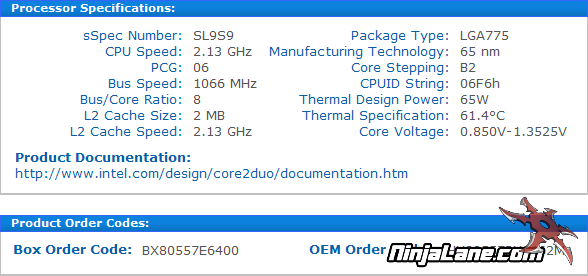After careful consideration I have decided to transfer all hardware review activities to a new domain. I purchased Hardwareasylum.com in 2012 and have been working hard to build a new and improved Ninjalane on that domain. If you are reading this you have reached one of the archived articles, news, projects and/or reviews that were left behind during the site migration.
Please update your bookmarks and be sure to visit the new and improved Ninjalane at Hardwareasylum.com
CoolJag Falcon 92-AL Review
Author: Dennis Garcia
Published: Sunday, June 24, 2007
Benchmarks
The CoolJag Falcon 92 AL is designed for all Intel 775 and Athlon64 processors; here is an overview of the system and testing methodology.
The system as it was tested
DFI the LANParty UT 680i LT
Pentium Core 2 Duo E6400 running at 2.13Ghz
CoolJag Falcon 92 AL
OEM Heatsink
Smart Guardian was used to obtain and record system temperature data and being that this is a dual core processor two programs were used to provide processor usage, Prime95 and AutoGK.
Pentium Core 2 Duo E6400 running at 2.13Ghz
CoolJag Falcon 92 AL
OEM Heatsink
Smart Guardian was used to obtain and record system temperature data and being that this is a dual core processor two programs were used to provide processor usage, Prime95 and AutoGK.

Editors note: Even though the Windows XP task manager reported 100% processor usage we could never attain a 100% of the rated heat output as documented by Intel (see below) when using Prime95 and AutoGK as a basis for that heat production. Knowing this both programs were run together until the maximum temperature was attainted and stabilized.
Other things to consider when judging software induced heat output.
a) Clock throttling by the processor at high temperatures.
b) Normal software isn't designed to produce maximum heat output.
c) Variances of cooling temperature.
d) Variances in CPU load.
e) Inaccuracies in thermal diode readouts.
Of course the list goes on..
Our testing methodology is aimed to provide a real world look into this heatsink given the test system provided.
Other things to consider when judging software induced heat output.
a) Clock throttling by the processor at high temperatures.
b) Normal software isn't designed to produce maximum heat output.
c) Variances of cooling temperature.
d) Variances in CPU load.
e) Inaccuracies in thermal diode readouts.
Of course the list goes on..
Our testing methodology is aimed to provide a real world look into this heatsink given the test system provided.
Default

A C/W rating can quickly be calculated using this formula.
C/W = (CPU temp - Ambient temp)/(Variance(%) * CPU Watts)
Allowed variance for this test = 80%
CPU Watts = 65W
0.63 C/W = (58C - 25C)/(.8(65W))
C/W = (CPU temp - Ambient temp)/(Variance(%) * CPU Watts)
Allowed variance for this test = 80%
CPU Watts = 65W
0.63 C/W = (58C - 25C)/(.8(65W))
Overclocked
For this next test the FSB was cranked up to 400Mhz and the test was re-run.


To calculate a new C/W rating for this test we will need to factor in the increased processor wattage. The formula and constants for this are listed below.
ocC/W = dCPU Watts * (ocMhz / dMhz) * (ocVcore / dVcore)2
ocMhz = 2800
dMhz = 2130
ocVcore = 1.4
dVcore = 1.2
The variance still applies for our C/W calculation
Allowed variance for this test = 80%
CPU Watts = W
0.43 C/W = (65C - 25C)/(.8(116.1W))
ocC/W = dCPU Watts * (ocMhz / dMhz) * (ocVcore / dVcore)2
ocMhz = 2800
dMhz = 2130
ocVcore = 1.4
dVcore = 1.2
The variance still applies for our C/W calculation
Allowed variance for this test = 80%
CPU Watts = W
0.43 C/W = (65C - 25C)/(.8(116.1W))
Benchmark Conclusion
In our heatsink and waterblock tests we don't really focus on overall load temperatures but rather how well the product can remove heat given a specified heat load. Since this is a real world testing method we need to take into consideration real world variables and estimate tolerances. This is why we normally only apply 80% of the total wattage output to our heat calculations.
The resulting C/W number is used to rate how efficient a heatsink or waterblock is based on the given heat load. These numbers can be used to determine heat capacity, the larger the difference the less efficient the heatsink is. (aka not good for overclocking)
As expected the stock Intel heatsink is not the best solution for any kind of overclocking however the CoolJag Falcon 92 AL did a pretty good job at keeping overall temperatures down and even lowered the C/W in our overclocking test. Since the heatpipe works on temperature differentials we can expect better performance when the temperature difference is greater.
Keep in mind these calculations are provided for demonstration purposes only and may not reflect the actual lab tested C/W rating, but we're pretty close
The resulting C/W number is used to rate how efficient a heatsink or waterblock is based on the given heat load. These numbers can be used to determine heat capacity, the larger the difference the less efficient the heatsink is. (aka not good for overclocking)
As expected the stock Intel heatsink is not the best solution for any kind of overclocking however the CoolJag Falcon 92 AL did a pretty good job at keeping overall temperatures down and even lowered the C/W in our overclocking test. Since the heatpipe works on temperature differentials we can expect better performance when the temperature difference is greater.
Keep in mind these calculations are provided for demonstration purposes only and may not reflect the actual lab tested C/W rating, but we're pretty close

